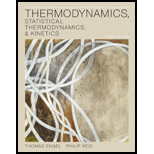
Thermodynamics, Statistical Thermodynamics, & Kinetics
3rd Edition
ISBN: 9780321766182
Author: Thomas Engel, Philip Reid
Publisher: Prentice Hall
expand_more
expand_more
format_list_bulleted
Concept explainers
Question
Chapter 3, Problem 3.13CP
Interpretation Introduction
Interpretation:The reason for equation ΔH=Tf∫TiCp(T)dT= Tf∫TiCp,m(T)dT to be valid for an ideal gas even if P is not constant in the process needs to be explained. Also, the validity of the equation for a real gas needs to be discussed.
Concept Introduction:
Different thermodynamic properties like enthalpy, entropy, free energy etc. are used to define different properties like volume, pressure and heat capacity.
Expert Solution & Answer
Want to see the full answer?
Check out a sample textbook solution
Students have asked these similar questions
How should I graph my data for the Absorbance of Pb and Fe for each mushroom? I want to compare the results to the known standard curve.
Software: Excel Spreadsheets
Link: https://mnscu-my.sharepoint.com/:x:/g/personal/vi2163ss_go_minnstate_edu/Eb2PfHdfEtBJiWh0ipHZ_kkBW4idWWwvpLPPtqoq2WkgbQ?rtime=HxrF0_tR3Ug
Provide the proper IUPAC name only for the following
compound. Dashes, commas, and spaces must be used
correctly, but do not use italics in Canvas.
The kinetics of a gas phase reaction of the form A → Products results in a rate constant of 0.00781 M/min. For this reaction, the initial concentration of A is 0.501 M. How many minutes will it take for the concentration of A to reach 0.144 M
Chapter 3 Solutions
Thermodynamics, Statistical Thermodynamics, & Kinetics
Ch. 3 - Prob. 3.1CPCh. 3 - Prob. 3.2CPCh. 3 - Prob. 3.3CPCh. 3 - Prob. 3.4CPCh. 3 - Why can qv be equated with a state function if q...Ch. 3 - Prob. 3.6CPCh. 3 - Prob. 3.7CPCh. 3 - Prob. 3.8CPCh. 3 - Prob. 3.9CPCh. 3 - Why is qv=U only for a constant volume process? Is...
Ch. 3 - Prob. 3.11CPCh. 3 - Why are q and w not state functions?Ch. 3 - Prob. 3.13CPCh. 3 - What is the relationship between a state function...Ch. 3 - Prob. 3.15CPCh. 3 - Is the following statement always, never, or...Ch. 3 - Is the following statement always, never, or...Ch. 3 - Prob. 3.18CPCh. 3 - Prob. 3.19CPCh. 3 - Is the expression UV=T2T1CVdT=nT1T2CV,mdT only...Ch. 3 - Prob. 3.1NPCh. 3 - Prob. 3.2NPCh. 3 - Prob. 3.3NPCh. 3 - Prob. 3.4NPCh. 3 - Prob. 3.5NPCh. 3 - Prob. 3.6NPCh. 3 - Integrate the expression =1/VV/TP assuming that ...Ch. 3 - Prob. 3.8NPCh. 3 - Prob. 3.9NPCh. 3 - Prob. 3.10NPCh. 3 - Prob. 3.11NPCh. 3 - Calculate w, q, H, and U for the process in which...Ch. 3 - Prob. 3.13NPCh. 3 - Prob. 3.14NPCh. 3 - Prob. 3.15NPCh. 3 - Prob. 3.16NPCh. 3 - Prob. 3.17NPCh. 3 - Prob. 3.18NPCh. 3 - Prob. 3.19NPCh. 3 - Prob. 3.20NPCh. 3 - Prob. 3.21NPCh. 3 - Prob. 3.22NPCh. 3 - Derive the following relation, UVmT=3a2TVmVm+b for...Ch. 3 - Prob. 3.24NPCh. 3 - Prob. 3.25NPCh. 3 - Prob. 3.26NPCh. 3 - Prob. 3.27NPCh. 3 - Prob. 3.28NPCh. 3 - Prob. 3.29NPCh. 3 - Prob. 3.30NPCh. 3 - Prob. 3.31NPCh. 3 - Prob. 3.32NPCh. 3 - Prob. 3.33NPCh. 3 - Prob. 3.34NPCh. 3 - Derive the equation H/TV=CV+V/k from basic...Ch. 3 - Prob. 3.36NPCh. 3 - Prob. 3.37NPCh. 3 - Show that CVVT=T2PT2VCh. 3 - Prob. 3.39NP
Knowledge Booster
Learn more about
Need a deep-dive on the concept behind this application? Look no further. Learn more about this topic, chemistry and related others by exploring similar questions and additional content below.Similar questions
- The reaction of 2-oxacyclopentanone with hydrochloric acid in water (i.e., "excess") produces which of the following carboxylic acids?arrow_forwardDon't used hand raiting and don't used Ai solutionarrow_forwardWhat is the name of the major product formed during the reaction between benzoyl chloride and phenol? benzyl ester O phenyl benzoate ○ cyclopentanoate ○ benzyl phenoate ○ benzenecarboxylic acidarrow_forward
- Provide the proper IUPAC or common name for the following compound. Dashes, commas, and spaces must be used correctly.arrow_forwardProvide the proper IUPAC name (only) for the following compound. Dashes, commas, and spaces must be used correctly. HO. OHarrow_forwardQuestion 2 0/1 pts Provide the proper IUPAC name only for the following compound. Dashes, commas, and spaces must be used correctly. HO CH 3 1-methyl-1-cyclohexanecarboxylic acidarrow_forward
arrow_back_ios
SEE MORE QUESTIONS
arrow_forward_ios
Recommended textbooks for you
 Physical ChemistryChemistryISBN:9781133958437Author:Ball, David W. (david Warren), BAER, TomasPublisher:Wadsworth Cengage Learning,
Physical ChemistryChemistryISBN:9781133958437Author:Ball, David W. (david Warren), BAER, TomasPublisher:Wadsworth Cengage Learning, ChemistryChemistryISBN:9781305957404Author:Steven S. Zumdahl, Susan A. Zumdahl, Donald J. DeCostePublisher:Cengage Learning
ChemistryChemistryISBN:9781305957404Author:Steven S. Zumdahl, Susan A. Zumdahl, Donald J. DeCostePublisher:Cengage Learning Chemistry: An Atoms First ApproachChemistryISBN:9781305079243Author:Steven S. Zumdahl, Susan A. ZumdahlPublisher:Cengage Learning
Chemistry: An Atoms First ApproachChemistryISBN:9781305079243Author:Steven S. Zumdahl, Susan A. ZumdahlPublisher:Cengage Learning
 Chemistry: The Molecular ScienceChemistryISBN:9781285199047Author:John W. Moore, Conrad L. StanitskiPublisher:Cengage Learning
Chemistry: The Molecular ScienceChemistryISBN:9781285199047Author:John W. Moore, Conrad L. StanitskiPublisher:Cengage Learning Principles of Modern ChemistryChemistryISBN:9781305079113Author:David W. Oxtoby, H. Pat Gillis, Laurie J. ButlerPublisher:Cengage Learning
Principles of Modern ChemistryChemistryISBN:9781305079113Author:David W. Oxtoby, H. Pat Gillis, Laurie J. ButlerPublisher:Cengage Learning

Physical Chemistry
Chemistry
ISBN:9781133958437
Author:Ball, David W. (david Warren), BAER, Tomas
Publisher:Wadsworth Cengage Learning,

Chemistry
Chemistry
ISBN:9781305957404
Author:Steven S. Zumdahl, Susan A. Zumdahl, Donald J. DeCoste
Publisher:Cengage Learning

Chemistry: An Atoms First Approach
Chemistry
ISBN:9781305079243
Author:Steven S. Zumdahl, Susan A. Zumdahl
Publisher:Cengage Learning


Chemistry: The Molecular Science
Chemistry
ISBN:9781285199047
Author:John W. Moore, Conrad L. Stanitski
Publisher:Cengage Learning

Principles of Modern Chemistry
Chemistry
ISBN:9781305079113
Author:David W. Oxtoby, H. Pat Gillis, Laurie J. Butler
Publisher:Cengage Learning
Calorimetry Concept, Examples and Thermochemistry | How to Pass Chemistry; Author: Melissa Maribel;https://www.youtube.com/watch?v=nSh29lUGj00;License: Standard YouTube License, CC-BY